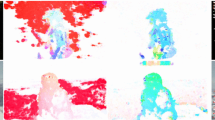Abstract.
In this article, we describe a module for the identification of brand logos from video data. A model for the visual appearance of each logo is generated from a small number of sample images using multidimensional histograms of scale-normalized chromatic Gaussian receptive fields. We compare several identification techniques based on multidimensional histograms. Each of the methods displays high recognition rates and can be used for logo identification. Our method for calculating scale-normalized Gaussian receptive fields has linear computational complexity and is thus well adapted to a real-time system. However, with the current generation of microprocessors we obtain at best only two images per second when processing a full PAL video stream. To accelerate the process, we propose an architecture that combines fast detection, reliable identification, and fast tracking for speedup. The resulting real-time system is evaluated using video streams from sports Formula 1 races and football.
Similar content being viewed by others
References
Agarwal S, Roth D (2002) Learning a sparse reprsentation for object detection. In: European conference on computer vision, pp 113-130
Belongie S, Malik J, Puzicha J (2002) Shape matching and object recognition using shape context. IEEE Trans Pattern Anal Mach Intell 24(4):509-522
Crowley JL, Riff O, Piater J (2002) Fast computation of characteristic scale using a half octave pyramid. In: Workshop on cognitive computing, Zurich, Switzerland
Freeman WT, Pasztor EC (1999) Learning low-level vision. In: International conference on computer vision, pp 1182-1189
Hall D, Colin de Verdiére V, Crowley JL (2000) Object recognition using coloured receptive fields. In: European conference on computer vision, pp 164-177 Dublin, Ireland
Lades M, Vorbrüggen JC, Buhmann J, Lange J, von der Mahlsburg C, Würz RP, Konen W (1993) Distortion invariant object recognition in the dynamic link architecture. Trans Comput 42(3):300-311
Lindeberg T (1998) Feature detection with automatic scale selection. Int J Comput Vision 30(2):79-116
Lowe DG (1999) Object recognition from local scale-invariant features. In: International conference on computer vision, pp 1150-1157
Osuna E, Freund R, Girosi F (1997) Training support vector machines: an application to face detection. In: IEEE conference on computer vision and pattern recognition, Puerto Rico, pp 130-136
Rao RPN, Ballard DH (1995) An active vision architecture based on iconic representations. Artif Intell 78(1-2):461-505
Schiele B, Crowley JL (2000) Recognition without correspondence using multidimensional receptive field histograms. Int J Comput Vision 36(1):31-50
Schiele B, Pentland A (1999) Probabilistic object recognition and localization. In: International conference on computer vision, Corfu, Greece, pp 177-182
Schmid C, Mohr R (1997) Local greyvalue invariants for image retrieval. IEEE Trans Pattern Anal Mach Intell 19(5):530-534
Schwerdt K, Crowley JL (2000) Robust face tracking using color. In: International conference on automatic face and gesture recognition, pp 90-95
Swain MJ, Ballard DH (1991) Color indexing. Int J Comput Vision 7(1):11-32
Author information
Authors and Affiliations
Corresponding author
Additional information
Published online: 6 October 2004
James L. Crowley: This research is funded by the European Commission’s IST project DETECT (IST-2001-32157).
Rights and permissions
About this article
Cite this article
Hall, D., Pélisson, F., Riff, O. et al. Brand identification using Gaussian derivative histograms. Machine Vision and Applications 16, 41–46 (2004). https://doi.org/10.1007/s00138-004-0146-5
Issue Date:
DOI: https://doi.org/10.1007/s00138-004-0146-5




